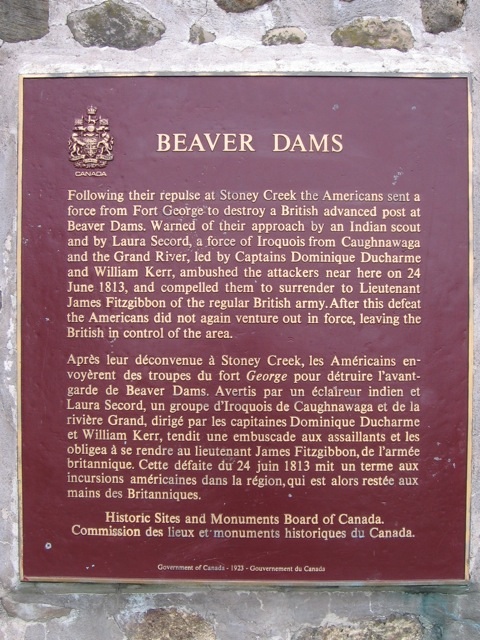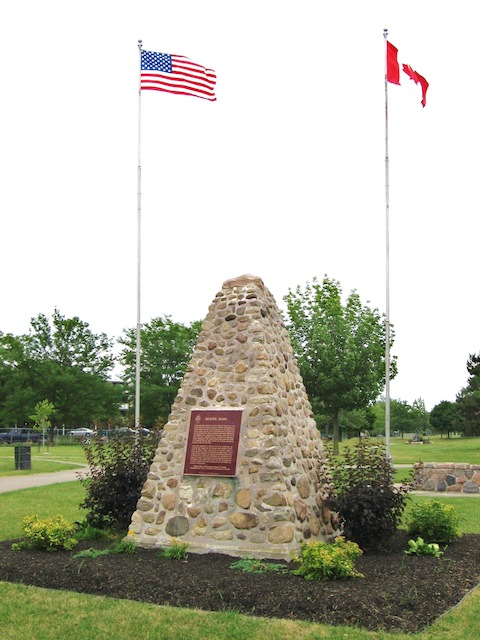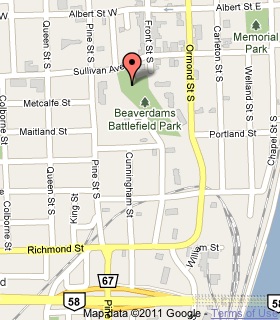Ontario's Historical Plaques
at ontarioplaques.com
Learn a little Ontario history as told through its plaques
Beaver Dams

Photos by contributor Wayne Adam - Posted June, 2009

Plaque Location
The Region of Niagara
The City of Thorold
In Beaverdams Battlefield Park, about three quarters
of the way between the parking lot on Ormond Street South
across from Portland Street and the
Sullivan Avenue pedestrian entrance
Coordinates: N 43 07.356 W 79 12.089 |
 |
Plaque Text
Following their repulse at Stoney Creek the Americans sent a force from Fort George to destroy a British advanced post at Beaver Dams. Warned of their approach by an Indian scout and by Laura Secord, a force of Iroquois from Caughnawaga and the Grand River, led by Captains Dominique Ducharme and William Kerr, ambushed the attackers near here on 24 June 1813, and compelled them to surrender to Lieutenant James Fitzgibbon of the regular British army. After this defeat the Americans did not again venture out in force, leaving the British in control of the area.
Related Ontario plaques
Battle of Stoney Creek
Fort George
Laura Secord (1775-1868)
More
Information
More
War of 1812
Here are the visitors' comments for this page.
Posted April 3, 2012
This site represents one of the earliest attempts to create a national historical park. In 1914, a convention of Ontario historical and patriotic groups resolved to ask the Department of the Interior "to develop a 40-acre site near Thorold as a national battlefield park commemorating the Battle of Beaver Dams."(1) The move may have been inspired by the creation, earlier that year, of Fort Howe National Park in New Brunswick--the first site admitted to the national park system on the basis of its historical significance.(2)
There were other galvanizing precedents. While there was no National Park Service in the United States until 1916, battlefields of the Civil War were designated and managed by the War Department: Chickamauga and Chattanooga (created 1890), Antietam (1890), Shiloh (1894), Gettysburg (1895), Vicksburg (1899), and Chalmette (1907).(3) In Quebec, the Plains of Abraham were developed as a landscaped historical park, following creation of the National Battlefields Commission in 1908. Yet none of these sites were administered by a national park service.
Had Beaver Dams been made a national parkland in 1914, it would have been the first battlefield within a national park system in either country. Moreover, if legislation had adopted the convention's recommendation, it would have been the first "National Battlefield Park" in Canada or the United States. (Existing U.S. battlefields had been designated National Military Parks, with one National Battlefield Site.(4))
Alas, Beaver Dams would never join the national park system. Discussion of a national battlefield here, however, along with the ad hoc creation of Fort Anne National Park in 1917, helped highlight the need for a coherent heritage policy, prompting the Interior minister to ask J.B. Harkin of the Parks Branch to develop one. That led to creation of the Historic Sites and Monuments Board in 1919--the genesis of national historic sites and historical parks for years to come. In 1921, soon after its formation, the Board designated the Battle of Beaver Dams a national historic site, one of its earliest selections.
Two years later, in 1923, this cairn was erected, but not where it is today. It was put up on the battlefield, near Davis Road and Old Thorold Stone Road, about 1.4 kilometers (0.87 miles) southeast of its present location. The original battle site is now unmarked, but remains the designated place of the national historic site, once the focus of those early efforts to create a National Battlefield Park. The cairn and its plaque were removed to their current location at Battle of Beaverdams [sic] Park, which was developed later in the 20th century.
-Wayne
Notes:
(1) Clarence M. Warner, president, Ontario Historical Society, to William J. Roche, Minister of the Interior, July 3, 1914. Cited in C.J. Taylor, Negotiating the Past: The Making of Canada's National Historic Parks and Sites, 1990, p. 30. (The Dominion Parks Branch was under the jurisdiction of the Department of the Interior.)
(2) Canada Gazette, vol. 47, n. 41, April 11, 1914, page 8. Fort Howe in Saint John, NB, was designated a National Park on March 30, 1914. It was returned to the city in 1930, later designated a national historic site outside the national park system.
(3) The National Parks: Shaping the System, U.S. National Park Service, 2005, p. 41. Battlefields would not be administered by the National Park Service until 1933.
(4) Ibid.
Here's where you can write a comment for this page.
Note: If you wish to ask me a question, please use the email link in the menu.
Note: Comments are moderated. Yours will appear on this page within 24 hours
(usually much sooner).
Note: As soon as the comment is posted, a link to it will appear on the home page in the section "Here are the 10 latest plaque pages with a new comment added by a visitor to this site."